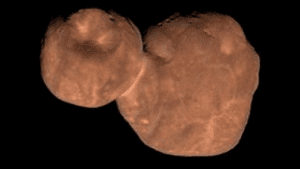TAG: GS 3: SCIENCE AND TECHNOLOGY
THE CONTEXT: Arrokoth, a distant object in the Kuiper Belt, has garnered significant attention due to its distinctive reddish hue and the presence of complex organic molecules.
EXPLANATION:
- This celestial body, the farthest Solar System object ever visited by a spacecraft, has revealed intriguing insights into the composition of early Solar System bodies.
Arrokoth
- Arrokoth was formerly known as 2014 MU69 and Ultima Thule.
- It was explored by NASA’s New Horizons spacecraft during its historic flyby in 2019.
- It is located beyond Neptune’s orbit.
- Arrokoth orbits the Sun in the Kuiper Belt, a region filled with icy bodies and remnants from the Solar System’s formation.
- The discovery of its unusual color prompted further investigation into its surface composition and the processes that could have led to its current state.
- A recent study has uncovered that Arrokoth’s reddish color is linked to the presence of complex organic molecules, specifically sugars.
- The analysis, conducted by scientists in the US and France, suggests that the surface contains significant amounts of glucose and other sugar compounds.
- These findings were published in the Proceedings of the National Academy of Sciences.

A composite image of Kuiper Belt Object Arrokoth
Research Methodology
- The research team utilized data collected from the New Horizons flyby to analyze the surface composition of Arrokoth.
- They also performed simulations to replicate the conditions Arrokoth has experienced over the past 1.8 billion years.
- This involved exposing methanol ices to galactic cosmic rays, which are high-energy particles from space that constantly bombard celestial bodies.
Formation of Sugars
- The simulations indicated that methanol ices, when subjected to cosmic rays, could produce a variety of sugar-type compounds.
- These compounds include biologically significant sugars such as ribose and glucose.
- The bombardment process resulted in the formation of organic molecules that would appear pinkish or red from space, depending on the angle of sunlight reflection.
- This phenomenon explains the reddish hue observed on Arrokoth.
Spectroscopic Features and Implications
- Spectroscopic analysis revealed pronounced features associated with methanol, further supporting the presence of complex organic molecules.
- The study also noted that some of the sugars formed on Arrokoth are similar to those found in RNA on Earth, suggesting intriguing possibilities about the building blocks of life.
- However, despite these findings, NASA has clarified that Arrokoth, located 4 billion miles from the Sun, is too cold to support life as we know it.
Kuiper belt
- The Kuiper Belt is a doughnut-shaped region of icy bodies extending far beyond the orbit of Neptune.
- It is home to Pluto and Arrokoth.
- Both worlds were visited by NASA’s New Horizons spacecraft.
- There may be millions of other icy worlds in the Kuiper Belt that were left over from the formation of our solar system.
- Scientists call these worlds Kuiper Belt objects (KBOs), or trans-Neptunian objects (TNOs).
- Trans-Neptunian objects are objects in our solar system that have an orbit beyond Neptune.

